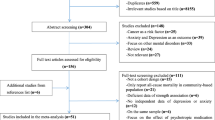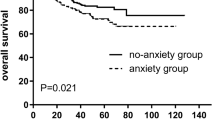Abstract
Purpose
This paper aimed to obtain information on the levels of anxiety and depression among cancer patients in China. The factors influencing these psychological problems were also analyzed.
Methods
A total of 1,217 cancer patients were interviewed, and each participant was asked to complete a self-administered questionnaire. The anxiety status, depression status, disease stage, tumor site, pain status, and performance status of the patients during the week prior to the interview were assessed.
Results
The anxiety and depression prevalence rates were 6.49 and 66.72 %, respectively. The prevalence rates of depression were 60.62 % for head and neck cancer, 77.19 % for lung cancer, 57.9 % for breast cancer, 75.81 % for esophagus cancer, 63.40 % for stomach cancer, 68.42 % for liver cancer, 54.37 % for colorectal cancer, and 71.13 % for cervix cancer. The factors influencing depression of patients were performance status (P < 0.0001), pain (P = 0.0003), age (P < 0.0001), and education level (P < 0.0001). The risk factors of anxiety were performance status (P = 0.0007), age (P < 0.0001), and gender (P < 0.0001).
Conclusions
Depression was a more important psychological problem than anxiety in cancer patients. Compared with 3.8 % of the prevalence of depression in normal population, depression level was high among Chinese cancer patients. Patients with lung, esophagus, and cervix cancers were the high-risk groups for depression. Poor performance status, pain, old age, and low-level education were the predicting factors for depression.
Similar content being viewed by others
References
Zhang YN, Zhang HW, Song LL, Tang LL (2010) Application of the NCCN Distress Thermometer in Chinese cancer patients. Chin Ment Health 24(12):897–901
Al-Shakhli H, Harcourt D, Kenealy J (2006) Psychological distress surrounding diagnosis of malignant and nonmalignant skin lesions at a pigmented lesion clinic. J Plast Reconstr Aesthet Surg 59:479–486. doi:10.1016/j.bjps.2005.01.010
Montazeri A, Milroy R, Hole D et al (1998) Anxiety and depression in patients with lung cancer before and after diagnosis: findings from a population in Glasgow, Scotland. J Epidemiol Community Health 52:203–204
Penelope H, Richard J (2000) Depression in patients with lung cancer: prevalence and risk factors derived from quality-of-life data. J Clin Oncol 18(4):893–903
Stoudemire A, Thompson TL (1983) Medication non-compliance: systematic approaches to evaluation and intervention. Gen Hosp Psychiatry 5:233–239
Tian J, Chen ZC, Hang LF (2009) The effects of psychological status of the patients with digestive system cancers on prognosis of the disease. Cancer Nurs 32(3):230–235
Gramignano G, Lusso MR, Madeddu C et al (2006) Efficacy of l-carnitine administration on fatigue, nutritional status, oxidative stress, and related quality of life in 12 advanced cancer patients undergoing anticancer therapy. Nutrition 2:136–145
Van CE, Arends J (2005) The causes and consequences of cancer-associated malnutrition. Eur J Oncol Nurs 2:S51–S63
Greer S (1983) Cancer and the mind. Br J Psychiatry 143:535–543
Miller AH (1998) Neuroendocrine and immune system interactions in stress and depression. Psychiatr Clin N Am 21:454–456
Massie MJ (2004) Prevalence of depression in patients with cancer. J Natl Cancer Inst Monogr 32:57–71
Chapman CR (1979) Psychological and behavioral aspects of cancer pain. Adv Pain Res Ther 2:45–56
Takahashi T, Hondo M, Nishimura K et al (2008) Evaluation of quality of life and psychological response in cancer patients treated with radiotherapy. Radiat Med 26:39–401
So WK, Marsh G, Ling WM et al (2009) Anxiety, depression and quality of life among Chinese breast cancer patients during adjuvant therapy. Eur J Oncol Nurs 14:17–22. doi:10.1016/j.ejon. 2009.07.005
Zabora J, BrintzenhofeSzoc K, Curbow B, Hooker C, Piantadosi S (2001) The prevalence of psychological distress by cancer site. Psychooncology 10:19–28
Strong V, Waters R, Hibberd C, Rush R, Cargill A, Storey D, Walker J, Wall L, Fallon M, Sharpe M (2007) Emotional distress in cancer patients: the Edinburgh Cancer Centre symptom study. Br J Cancer 96:868–874. doi:10.1038/sj.bjc.6603626
Pascoe S, Edelman S, Kidman A (2000) Prevalence of psychological distress and use of support services by cancer patients at Sydney hospitals. J Psychiatry 34:785–791
Ashraff S, Gupta SLA, Chaudhury LCS et al (2004) Effect of short-term psychiatric intervention in cancer patients. MJAFI 60:109–112
Korfage IJ, Essink-Bot ML, Janssens AC, Schröder FH, Koning HJ (2006) Anxiety and depression after prostate cancer diagnosis and treatment: 5-year follow-up. Br J Cancer 94:1093–1098
Tagay S, Herpertz S, Langkafel M et al (2006) Health-related quality of life, depression and anxiety in thyroid cancer patients. Care Rehab 15:695–703
Chen ML, Zhang HK, Yeh CH (2000) Anxiety and depression in Taiwanese cancer patients with and without pain. J Adv Nurs 32:944–951
Zabora J, BrintzenhofeSzoc K, Curbow B, Hooker C, Piantadosi S (2001) The prevalence of psychological distress by cancer site. Psych Oncol 10(1):19–28
Medeiros M, Oshima CT, Forones NM (2010) Depression and anxiety in colorectal cancer patients. J Gastrointest Cancer 41(3):179–184
Evans DL, McCartney CF, Nemeroff CB, Raft D, Quade D, Golden RN et al (1986) Depression in women treated for gynecological cancer: clinical and neuroendocrine assessment. Am J Psychiatry 143:447–451
Mashhadi MA, Mansoor S, Zahra Z (2013) Evaluation of depression in patients with cancer in South of Iran (Zahedan). Iran J Cancer Prev 6:112–116
Vukojević M, Perić I, Kordić M (2012) Anxiety and depression in oncology patients in the Mostar University Clinical Hospital. Lijec Vjesn 134(7–8):208–214
Tel H, Sari A, Aydin HT (2013) Social support and depression among the cancer patients. Glob J Med Res K: Interdiscip 13(3) Version 1.0 (online ISSN: 2249–4618)
Laird BJ, Boyd AC, Colvin LA, Fallon MT (2009) Are cancer pain and depression interdependent? A systematic review. Psychooncology 18(5):459–464
Jack L, Scott A, Colvin L, Laird B, Fallon M (2011) Pain and depression in cancer patients: a longitudinal study. BMJ Support Palliat Care 1:A11. doi:10.1136/bmjspcare-2011-000020.30
Jehn CF, Flath B, Strux A, Krebs M, Possinger K, Pezzutto A, Lüftner D (2012) Influence of age, performance status, cancer activity, and IL-6 on anxiety and depression in patients with metastatic breast cancer. Breast Cancer Res Treat 136(3):789–794
Lin CC, Lai YL (2003) Effect of cancer pain on performance status, mood states, and level of hope among Taiwanese cancer patients. J Pain Symptom Manag 25(1):29–37
Lansky SB, List MA, Hermann CA (1985) Absence of major depressive disorder in female cancer patients. J Clin Oncol 3:1553–1560
Vodermaier A, Linden W, MacKenzie R, Greig D, Marshall C (2011) Disease stage predicts post-diagnosis anxiety and depression only in some types of cancer. Br J Cancer 105(12):1814–1817. doi:10.1038/bjc.2011.503
Lueboonthavatchai P (2007) Prevalence and psychosocial factors of anxiety and depression in breast cancer patients. J Med Assoc Thail 90(10):2164–2174
Wang XD, Wang XL, Ma H (1999) Rating scales for mental health. Zhongguo Xingli Weisheng Zazhi, Beijing
Zigmond AS, Snaith RP (1983) The hospital anxiety and depression scale. Acta Psychiatr Scand 67:361–370
Leung CM, Ho S, Kan CS, Hung CH, Chen CN (1990) Evaluation of the Chinese version of the Hospital Anxiety and Depression Scale. A cross-cultural perspective. Int J Psychsom 40(4):29–34
Gao LP, Weng CS (2008) Influencing factors of quality of life in cancer patients of initial stages receiving radio- and chemotherapy and its countermeasures. Nurs J Chin People's Liberation Army 8:10–12
Spijker AV, Trijsberg RW, Duivenvoorden HJ (1997) Psychological sequelae of cancer diagnosis: a meta-analytical review of 58 studies after 1980. Psychosom Med 59:280–293
Zang YJ, Zao Z, Meng JX (2004) The clinical analysis for anxiety and depression of hypertension patients. Med J Chin People Health 116(111):675–676
Cancer Institute of China (2001) The incidences and mortalities of malignant tumors in some regions of China, vol 1. China Medical Technology, Beijing, pp 1–39
Liu Y, Wang YF, Shong LQ et al (2007) The progress in the study on depression of cancer patients. Chin J of Beh Med Sci l16(11):1054–1056
Wan CH, Luo JH, Yang Z, Meng Q (2007) Measurements and applications of quality of life in patients with cancers. Kexue, Beijing
Fernandes WC, Kimura M (2010) Health related quality of life of women with cervical cancer. Rev Latino-Am Enfermagem 18(3):360–367
Burns M, Costello J, Ryan-Woolley B, Davidson S (2007) Assessing the impact of late treatment effects in cervical cancer: an exploratory study of women's sexuality. Eur J Cancer Care 16:364–372
Wei RC (2010) The sex life and its influencing factors in cervical cancer patients after surgery. Chin J Nurs 45(9):843–844
Chen X, Lu W, Zheng Y et al (2010) Exercise, tea consumption, and depression among breast cancer survivors. J Clin Oncol 28:991–998
Grav S, Hellzèn O, Romild U, Stordal E (2012) Association between social support and depression in the general population: the HUNT study, a cross-sectional survey. J Clin Nurs 21(1–2):111–120
Mohr DC, Classen C, Barrera M Jr (2004) The relationship between social support, depression and treatment for depression in people with multiple sclerosis. Psychol Med 34(3):533–541
Conflict of interest
The authors have no conflicts of interest to declare. This study has no financial relationship with any organization that sponsored the research and authorship. The corresponding author has full control of all primary data and will allow the journal to review the data if requested.
Author information
Authors and Affiliations
Corresponding author
Rights and permissions
About this article
Cite this article
Hong, J.S., Tian, J. Prevalence of anxiety and depression and their risk factors in Chinese cancer patients. Support Care Cancer 22, 453–459 (2014). https://doi.org/10.1007/s00520-013-1997-y
Received:
Accepted:
Published:
Issue Date:
DOI: https://doi.org/10.1007/s00520-013-1997-y




